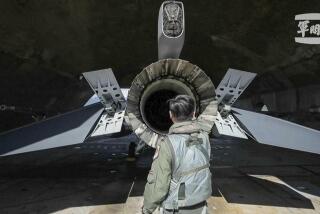Taiwan Deal May Up Pentagon Cost : Aerospace: The government would pay about $350 million more for a fleet of C-17 jets if McDonnell Douglas sells stake to overseas group, the Air Force says.
- Share via
The government would pay an estimated $350 million more for its fleet of McDonnell Douglas C-17 cargo jets as a result of the firm’s plan to sell a stake in its commercial aircraft business to a Taiwanese group, Air Force officials said Tuesday.
McDonnell--by splitting its Douglas Aircraft unit into separate commercial and military divisions as part of the deal--would increase “overhead” costs on the 120-plane C-17 program by about $3 million per aircraft, according to a study by the Air Force and the Defense Contract Management Command.
While McDonnell officials have testified in recent congressional hearings that the sale to Taiwan Aerospace Corp. would protect American technology and jobs, the question of how the deal would affect the Pentagon’s costs never was raised, members of Congress and their staffs said Tuesday.
The $350-million figure is the government’s “best estimate” of the potential cost impact, representing about 1% of the C-17 program’s total $35-billion cost, according to a spokesman for the Air Force Aeronautical Systems Division in Dayton, Ohio. The added costs could rise to about $1 billion in the worst case or total less than the $350 million in the best case, he added.
McDonnell signed a preliminary agreement last November to sell Taiwan Aerospace up to 40% of its troubled commercial aircraft business in Long Beach for $2 billion. The deal may yet be restructured or scaled back, as officials in Taiwan weigh the findings of a comprehensive review of the transaction. A McDonnell spokesman declined to comment Tuesday on the Air Force cost estimates.
The increase in overhead costs on the huge cargo jets apparently would include facility costs, certain staff salaries and other costs that up to now have been pooled with the firm’s commercial programs. The government would bear the additional overhead costs on future C-17 production contracts, which are negotiated annually.
In addition, some work performed by the commercial operation for the C-17 would have to be negotiated between the two organizations, according to Brig. Gen. Kenneth G. Miller, the Air Force’s C-17 program manager.
The potential for a cost increase evoked a loud reaction from some members of Congress, who have expressed concern that the Taiwan deal would harm American interests.
Sen. Jeff Bingaman (D-N.M.), chairman of the Joint Economic Committee, said that after two hearings by his panel on the Taiwan deal, he was left with the impression that McDonnell’s strong defense business historically had subsidized its weak commercial aircraft business--not the reverse.
“I have trouble squaring that notion with this conclusion by the Air Force,” Bingaman said. “I have real trouble getting that to compute.”
Rep. John Conyers Jr. (D-Mich.), chairman of the House Government Operations Committee and one of the firm’s harshest critics, issued this statement: “We have long suspected that the C-17 would feel the impact of the McDonnell Douglas sale to the Taiwanese. The American taxpayers should not and will not foot the bill for this transfer.” Meanwhile, Miller, the Air Force’s C-17 program manager, said in a wide-ranging interview last week that McDonnell is making good progress in improving its efficiency on the C-17 program.
But the improvements had been anticipated, and Miller said the firm is still likely to incur an $850-million cost overrun on the first six planes. McDonnell has insisted that it will break even.
Miller said the firm is building each subsequent C-17 with just 75% of the labor hours of the previous aircraft--a measure of McDonnell’s “learning” process.
Although Miller said that rate is about average compared to other programs, it apparently is not enough to save McDonnell from huge losses looming on the C-17. Rather, that learning curve confirms Air Force estimates that it will cost $7.45 billion to complete the initial C-17 contract.
Still, Miller was upbeat about the aircraft itself.
“We know their manufacturing process has more refinements that need to be made, but the product that is coming out the door is magnificent,” the general said.
“Could they do it more efficiently? Yes. Is it perfect as it comes down the production line? No. But between their quality assurance folks and the (defense) quality assurance folks, what actually comes out the door and what is delivered to the Air Force, the taxpayer, is a magnificent flying machine,” he said. “And we are thrilled to death with its performance so far in the test program. It is really more than anybody would reasonably hope for when you look at any airplane that has come along in the past 50 years in the Air Force.”
Still, the Air Force and McDonnell have had to postpone flying the first production model until mid-April after a test model had to be grounded three times since Oct. 31 at Edwards Air Force Base because of fuel leak concerns.
After intensively reviewing the problem, Miller said it appears that the firm’s procedures and worker training need improvement.
More to Read
Inside the business of entertainment
The Wide Shot brings you news, analysis and insights on everything from streaming wars to production — and what it all means for the future.
You may occasionally receive promotional content from the Los Angeles Times.











